Psychology Case Study: Erectile Dysfunction, Relationship Dynamics
VerifiedAdded on 2022/08/20
|8
|2589
|15
Case Study
AI Summary
This case study examines the case of Pete and Paula, a couple experiencing relationship difficulties after Pete developed erectile dysfunction shortly after moving in with Paula. The analysis explores potential causes, including psychological and psychosocial factors, such as personality differences, Paula's aggressive behavior, and differing preferences in lifestyle and hobbies. The study differentiates between paraphilia and acquired erectile dysfunction, highlighting the role of relationship dynamics, partner factors, and individual vulnerabilities like stress and anxiety. It delves into how Paula's dominating attitude, verbal and physical abuse, and the couple's conflicts contribute to Pete's condition. The case study emphasizes the influence of psychological comorbidities, relationship stressors, and differing expectations on the development of erectile dysfunction. The study eliminates paraphilia as a diagnosis and focuses on the acquired nature of Pete's erectile dysfunction, emphasizing the impact of relationship factors on his sexual health and well-being.
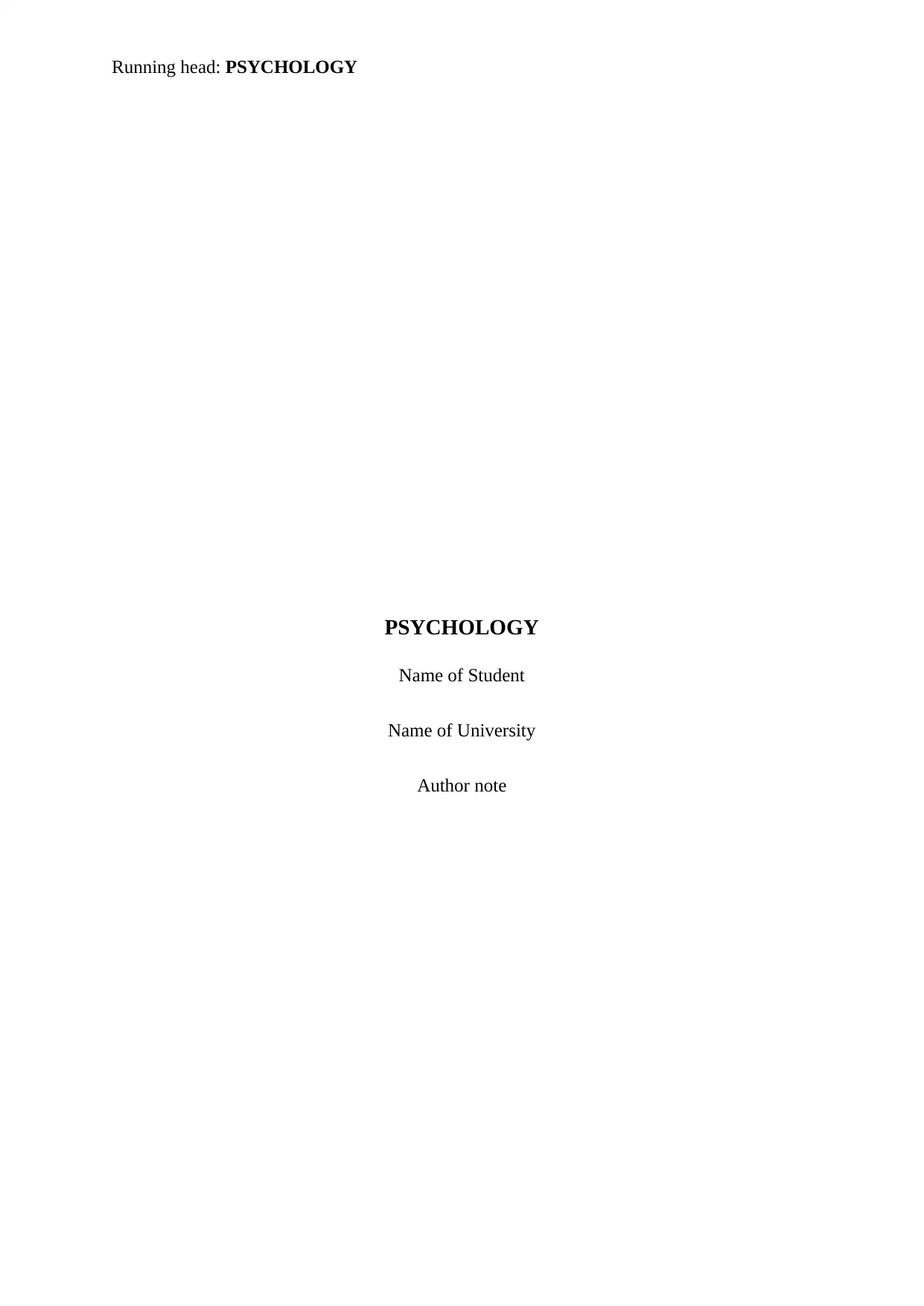
Running head: PSYCHOLOGY
PSYCHOLOGY
Name of Student
Name of University
Author note
PSYCHOLOGY
Name of Student
Name of University
Author note
Paraphrase This Document
Need a fresh take? Get an instant paraphrase of this document with our AI Paraphraser
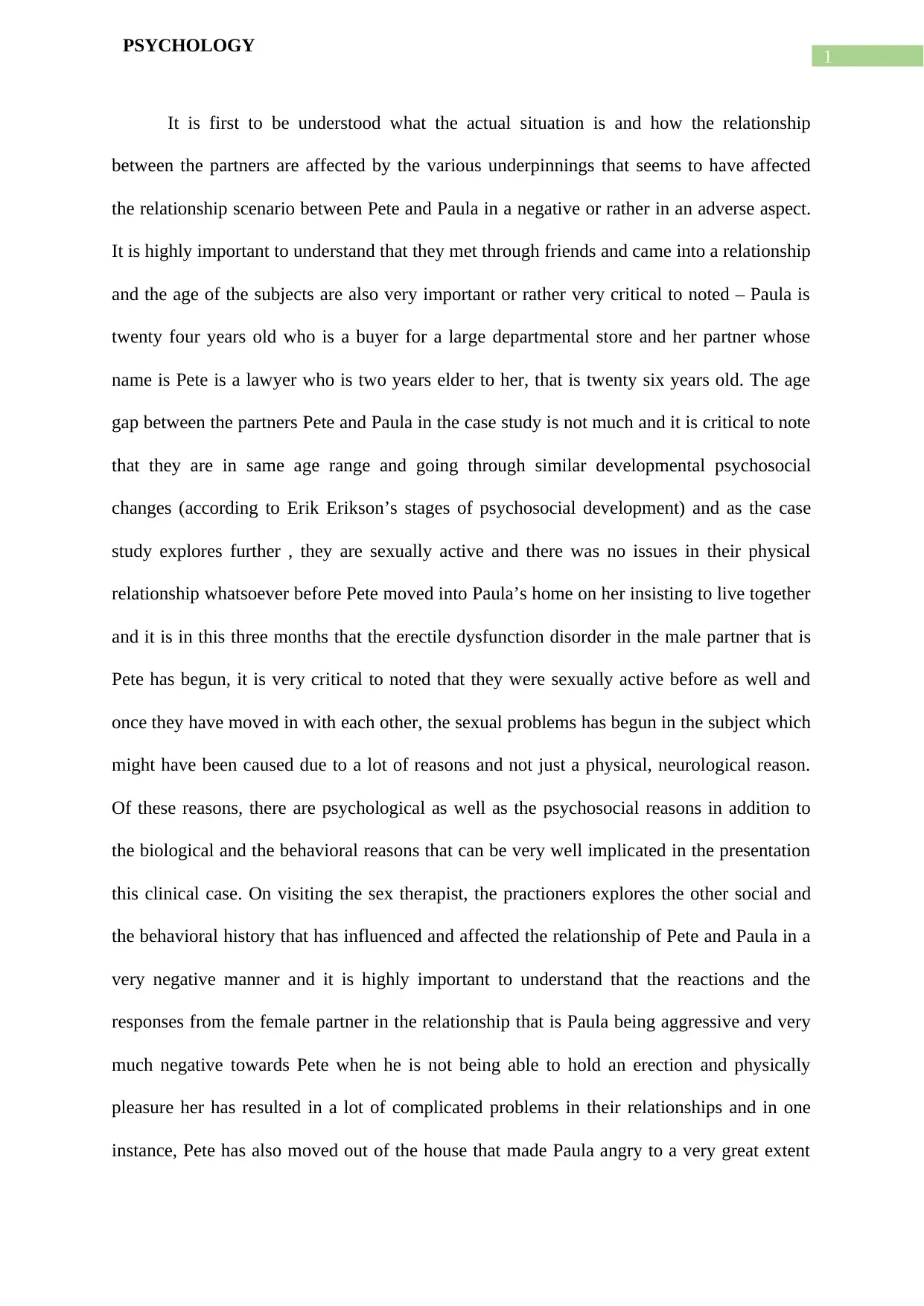
1
PSYCHOLOGY
It is first to be understood what the actual situation is and how the relationship
between the partners are affected by the various underpinnings that seems to have affected
the relationship scenario between Pete and Paula in a negative or rather in an adverse aspect.
It is highly important to understand that they met through friends and came into a relationship
and the age of the subjects are also very important or rather very critical to noted – Paula is
twenty four years old who is a buyer for a large departmental store and her partner whose
name is Pete is a lawyer who is two years elder to her, that is twenty six years old. The age
gap between the partners Pete and Paula in the case study is not much and it is critical to note
that they are in same age range and going through similar developmental psychosocial
changes (according to Erik Erikson’s stages of psychosocial development) and as the case
study explores further , they are sexually active and there was no issues in their physical
relationship whatsoever before Pete moved into Paula’s home on her insisting to live together
and it is in this three months that the erectile dysfunction disorder in the male partner that is
Pete has begun, it is very critical to noted that they were sexually active before as well and
once they have moved in with each other, the sexual problems has begun in the subject which
might have been caused due to a lot of reasons and not just a physical, neurological reason.
Of these reasons, there are psychological as well as the psychosocial reasons in addition to
the biological and the behavioral reasons that can be very well implicated in the presentation
this clinical case. On visiting the sex therapist, the practioners explores the other social and
the behavioral history that has influenced and affected the relationship of Pete and Paula in a
very negative manner and it is highly important to understand that the reactions and the
responses from the female partner in the relationship that is Paula being aggressive and very
much negative towards Pete when he is not being able to hold an erection and physically
pleasure her has resulted in a lot of complicated problems in their relationships and in one
instance, Pete has also moved out of the house that made Paula angry to a very great extent
PSYCHOLOGY
It is first to be understood what the actual situation is and how the relationship
between the partners are affected by the various underpinnings that seems to have affected
the relationship scenario between Pete and Paula in a negative or rather in an adverse aspect.
It is highly important to understand that they met through friends and came into a relationship
and the age of the subjects are also very important or rather very critical to noted – Paula is
twenty four years old who is a buyer for a large departmental store and her partner whose
name is Pete is a lawyer who is two years elder to her, that is twenty six years old. The age
gap between the partners Pete and Paula in the case study is not much and it is critical to note
that they are in same age range and going through similar developmental psychosocial
changes (according to Erik Erikson’s stages of psychosocial development) and as the case
study explores further , they are sexually active and there was no issues in their physical
relationship whatsoever before Pete moved into Paula’s home on her insisting to live together
and it is in this three months that the erectile dysfunction disorder in the male partner that is
Pete has begun, it is very critical to noted that they were sexually active before as well and
once they have moved in with each other, the sexual problems has begun in the subject which
might have been caused due to a lot of reasons and not just a physical, neurological reason.
Of these reasons, there are psychological as well as the psychosocial reasons in addition to
the biological and the behavioral reasons that can be very well implicated in the presentation
this clinical case. On visiting the sex therapist, the practioners explores the other social and
the behavioral history that has influenced and affected the relationship of Pete and Paula in a
very negative manner and it is highly important to understand that the reactions and the
responses from the female partner in the relationship that is Paula being aggressive and very
much negative towards Pete when he is not being able to hold an erection and physically
pleasure her has resulted in a lot of complicated problems in their relationships and in one
instance, Pete has also moved out of the house that made Paula angry to a very great extent
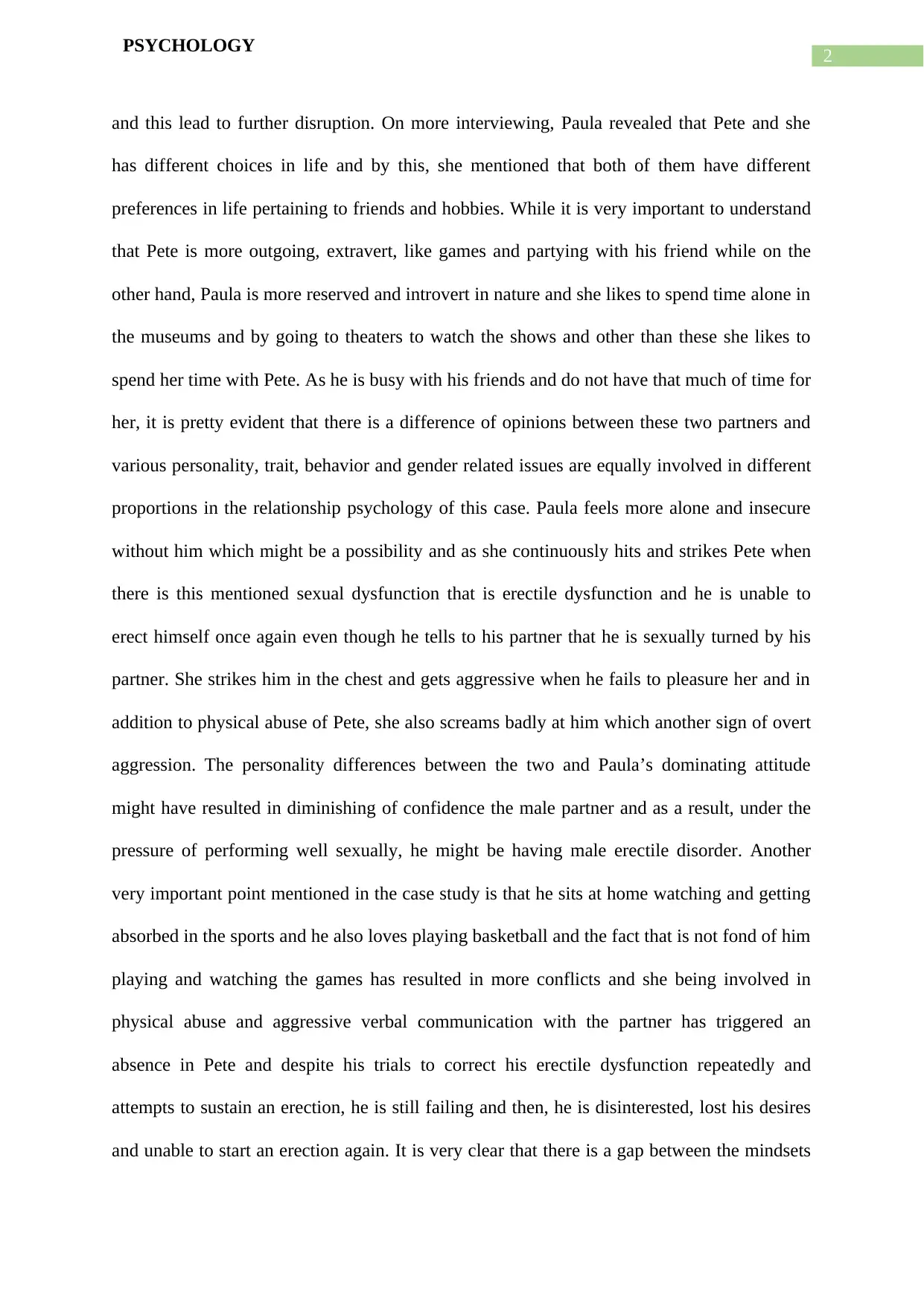
2
PSYCHOLOGY
and this lead to further disruption. On more interviewing, Paula revealed that Pete and she
has different choices in life and by this, she mentioned that both of them have different
preferences in life pertaining to friends and hobbies. While it is very important to understand
that Pete is more outgoing, extravert, like games and partying with his friend while on the
other hand, Paula is more reserved and introvert in nature and she likes to spend time alone in
the museums and by going to theaters to watch the shows and other than these she likes to
spend her time with Pete. As he is busy with his friends and do not have that much of time for
her, it is pretty evident that there is a difference of opinions between these two partners and
various personality, trait, behavior and gender related issues are equally involved in different
proportions in the relationship psychology of this case. Paula feels more alone and insecure
without him which might be a possibility and as she continuously hits and strikes Pete when
there is this mentioned sexual dysfunction that is erectile dysfunction and he is unable to
erect himself once again even though he tells to his partner that he is sexually turned by his
partner. She strikes him in the chest and gets aggressive when he fails to pleasure her and in
addition to physical abuse of Pete, she also screams badly at him which another sign of overt
aggression. The personality differences between the two and Paula’s dominating attitude
might have resulted in diminishing of confidence the male partner and as a result, under the
pressure of performing well sexually, he might be having male erectile disorder. Another
very important point mentioned in the case study is that he sits at home watching and getting
absorbed in the sports and he also loves playing basketball and the fact that is not fond of him
playing and watching the games has resulted in more conflicts and she being involved in
physical abuse and aggressive verbal communication with the partner has triggered an
absence in Pete and despite his trials to correct his erectile dysfunction repeatedly and
attempts to sustain an erection, he is still failing and then, he is disinterested, lost his desires
and unable to start an erection again. It is very clear that there is a gap between the mindsets
PSYCHOLOGY
and this lead to further disruption. On more interviewing, Paula revealed that Pete and she
has different choices in life and by this, she mentioned that both of them have different
preferences in life pertaining to friends and hobbies. While it is very important to understand
that Pete is more outgoing, extravert, like games and partying with his friend while on the
other hand, Paula is more reserved and introvert in nature and she likes to spend time alone in
the museums and by going to theaters to watch the shows and other than these she likes to
spend her time with Pete. As he is busy with his friends and do not have that much of time for
her, it is pretty evident that there is a difference of opinions between these two partners and
various personality, trait, behavior and gender related issues are equally involved in different
proportions in the relationship psychology of this case. Paula feels more alone and insecure
without him which might be a possibility and as she continuously hits and strikes Pete when
there is this mentioned sexual dysfunction that is erectile dysfunction and he is unable to
erect himself once again even though he tells to his partner that he is sexually turned by his
partner. She strikes him in the chest and gets aggressive when he fails to pleasure her and in
addition to physical abuse of Pete, she also screams badly at him which another sign of overt
aggression. The personality differences between the two and Paula’s dominating attitude
might have resulted in diminishing of confidence the male partner and as a result, under the
pressure of performing well sexually, he might be having male erectile disorder. Another
very important point mentioned in the case study is that he sits at home watching and getting
absorbed in the sports and he also loves playing basketball and the fact that is not fond of him
playing and watching the games has resulted in more conflicts and she being involved in
physical abuse and aggressive verbal communication with the partner has triggered an
absence in Pete and despite his trials to correct his erectile dysfunction repeatedly and
attempts to sustain an erection, he is still failing and then, he is disinterested, lost his desires
and unable to start an erection again. It is very clear that there is a gap between the mindsets
⊘ This is a preview!⊘
Do you want full access?
Subscribe today to unlock all pages.

Trusted by 1+ million students worldwide
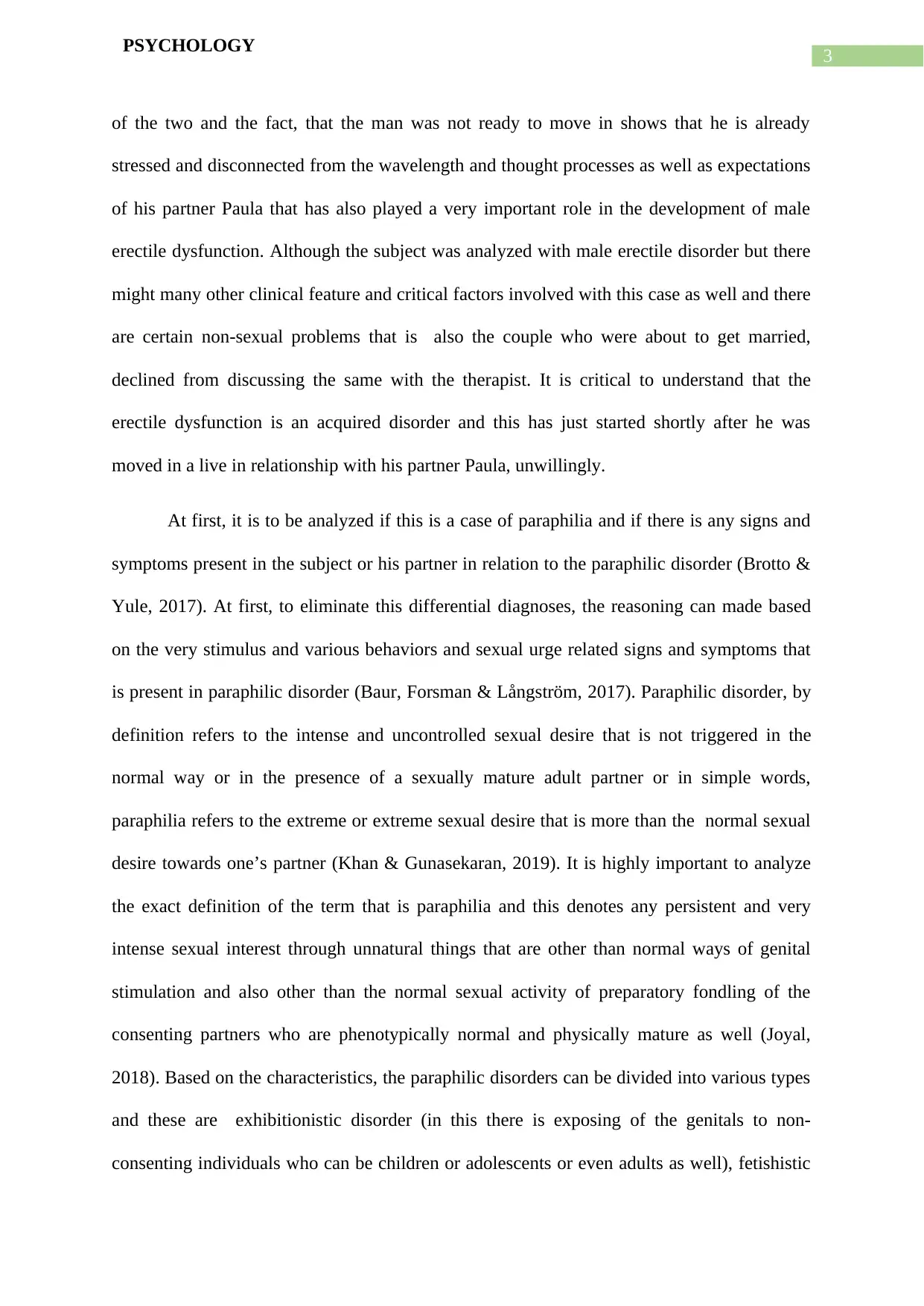
3
PSYCHOLOGY
of the two and the fact, that the man was not ready to move in shows that he is already
stressed and disconnected from the wavelength and thought processes as well as expectations
of his partner Paula that has also played a very important role in the development of male
erectile dysfunction. Although the subject was analyzed with male erectile disorder but there
might many other clinical feature and critical factors involved with this case as well and there
are certain non-sexual problems that is also the couple who were about to get married,
declined from discussing the same with the therapist. It is critical to understand that the
erectile dysfunction is an acquired disorder and this has just started shortly after he was
moved in a live in relationship with his partner Paula, unwillingly.
At first, it is to be analyzed if this is a case of paraphilia and if there is any signs and
symptoms present in the subject or his partner in relation to the paraphilic disorder (Brotto &
Yule, 2017). At first, to eliminate this differential diagnoses, the reasoning can made based
on the very stimulus and various behaviors and sexual urge related signs and symptoms that
is present in paraphilic disorder (Baur, Forsman & Långström, 2017). Paraphilic disorder, by
definition refers to the intense and uncontrolled sexual desire that is not triggered in the
normal way or in the presence of a sexually mature adult partner or in simple words,
paraphilia refers to the extreme or extreme sexual desire that is more than the normal sexual
desire towards one’s partner (Khan & Gunasekaran, 2019). It is highly important to analyze
the exact definition of the term that is paraphilia and this denotes any persistent and very
intense sexual interest through unnatural things that are other than normal ways of genital
stimulation and also other than the normal sexual activity of preparatory fondling of the
consenting partners who are phenotypically normal and physically mature as well (Joyal,
2018). Based on the characteristics, the paraphilic disorders can be divided into various types
and these are exhibitionistic disorder (in this there is exposing of the genitals to non-
consenting individuals who can be children or adolescents or even adults as well), fetishistic
PSYCHOLOGY
of the two and the fact, that the man was not ready to move in shows that he is already
stressed and disconnected from the wavelength and thought processes as well as expectations
of his partner Paula that has also played a very important role in the development of male
erectile dysfunction. Although the subject was analyzed with male erectile disorder but there
might many other clinical feature and critical factors involved with this case as well and there
are certain non-sexual problems that is also the couple who were about to get married,
declined from discussing the same with the therapist. It is critical to understand that the
erectile dysfunction is an acquired disorder and this has just started shortly after he was
moved in a live in relationship with his partner Paula, unwillingly.
At first, it is to be analyzed if this is a case of paraphilia and if there is any signs and
symptoms present in the subject or his partner in relation to the paraphilic disorder (Brotto &
Yule, 2017). At first, to eliminate this differential diagnoses, the reasoning can made based
on the very stimulus and various behaviors and sexual urge related signs and symptoms that
is present in paraphilic disorder (Baur, Forsman & Långström, 2017). Paraphilic disorder, by
definition refers to the intense and uncontrolled sexual desire that is not triggered in the
normal way or in the presence of a sexually mature adult partner or in simple words,
paraphilia refers to the extreme or extreme sexual desire that is more than the normal sexual
desire towards one’s partner (Khan & Gunasekaran, 2019). It is highly important to analyze
the exact definition of the term that is paraphilia and this denotes any persistent and very
intense sexual interest through unnatural things that are other than normal ways of genital
stimulation and also other than the normal sexual activity of preparatory fondling of the
consenting partners who are phenotypically normal and physically mature as well (Joyal,
2018). Based on the characteristics, the paraphilic disorders can be divided into various types
and these are exhibitionistic disorder (in this there is exposing of the genitals to non-
consenting individuals who can be children or adolescents or even adults as well), fetishistic
Paraphrase This Document
Need a fresh take? Get an instant paraphrase of this document with our AI Paraphraser
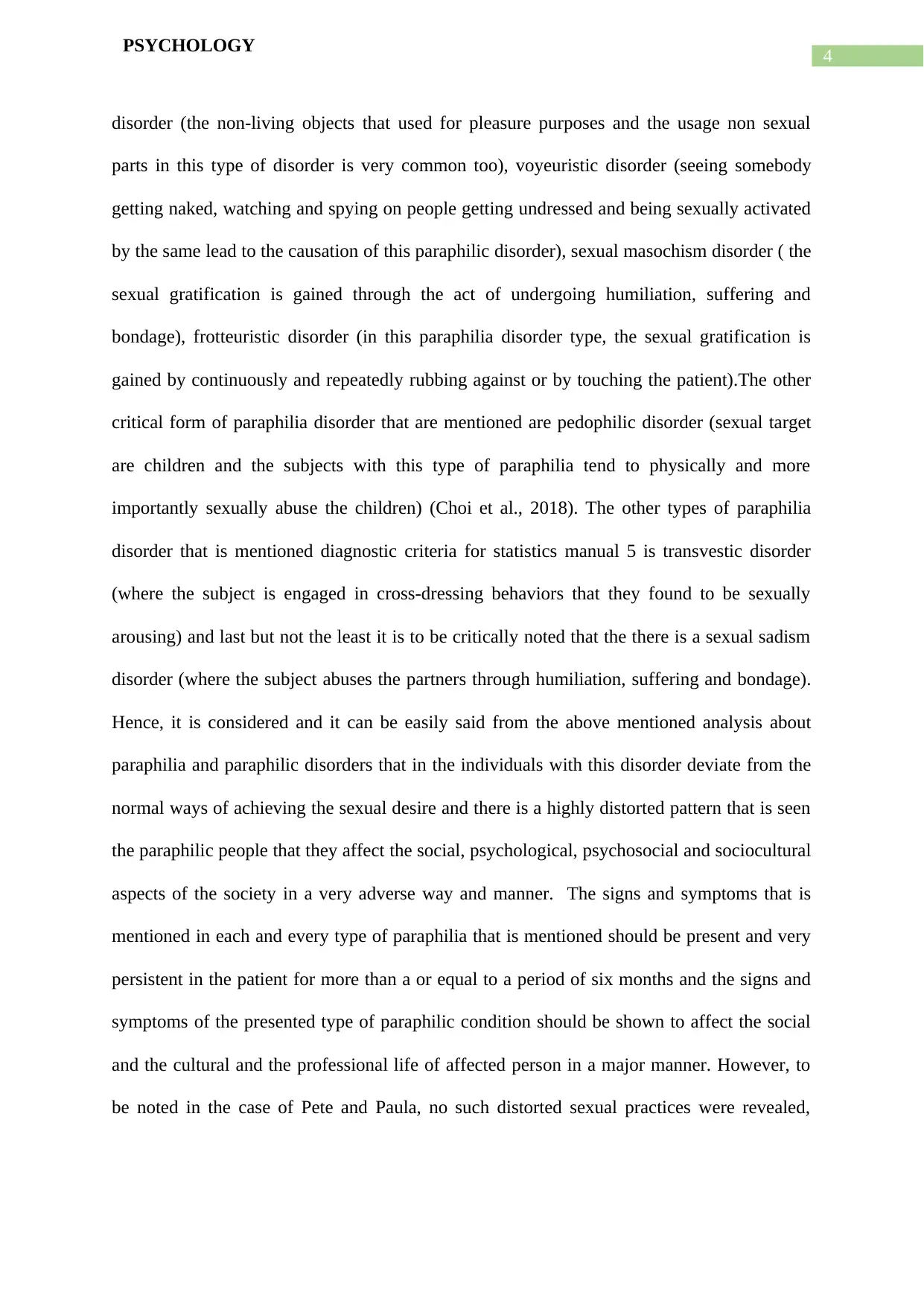
4
PSYCHOLOGY
disorder (the non-living objects that used for pleasure purposes and the usage non sexual
parts in this type of disorder is very common too), voyeuristic disorder (seeing somebody
getting naked, watching and spying on people getting undressed and being sexually activated
by the same lead to the causation of this paraphilic disorder), sexual masochism disorder ( the
sexual gratification is gained through the act of undergoing humiliation, suffering and
bondage), frotteuristic disorder (in this paraphilia disorder type, the sexual gratification is
gained by continuously and repeatedly rubbing against or by touching the patient).The other
critical form of paraphilia disorder that are mentioned are pedophilic disorder (sexual target
are children and the subjects with this type of paraphilia tend to physically and more
importantly sexually abuse the children) (Choi et al., 2018). The other types of paraphilia
disorder that is mentioned diagnostic criteria for statistics manual 5 is transvestic disorder
(where the subject is engaged in cross-dressing behaviors that they found to be sexually
arousing) and last but not the least it is to be critically noted that the there is a sexual sadism
disorder (where the subject abuses the partners through humiliation, suffering and bondage).
Hence, it is considered and it can be easily said from the above mentioned analysis about
paraphilia and paraphilic disorders that in the individuals with this disorder deviate from the
normal ways of achieving the sexual desire and there is a highly distorted pattern that is seen
the paraphilic people that they affect the social, psychological, psychosocial and sociocultural
aspects of the society in a very adverse way and manner. The signs and symptoms that is
mentioned in each and every type of paraphilia that is mentioned should be present and very
persistent in the patient for more than a or equal to a period of six months and the signs and
symptoms of the presented type of paraphilic condition should be shown to affect the social
and the cultural and the professional life of affected person in a major manner. However, to
be noted in the case of Pete and Paula, no such distorted sexual practices were revealed,
PSYCHOLOGY
disorder (the non-living objects that used for pleasure purposes and the usage non sexual
parts in this type of disorder is very common too), voyeuristic disorder (seeing somebody
getting naked, watching and spying on people getting undressed and being sexually activated
by the same lead to the causation of this paraphilic disorder), sexual masochism disorder ( the
sexual gratification is gained through the act of undergoing humiliation, suffering and
bondage), frotteuristic disorder (in this paraphilia disorder type, the sexual gratification is
gained by continuously and repeatedly rubbing against or by touching the patient).The other
critical form of paraphilia disorder that are mentioned are pedophilic disorder (sexual target
are children and the subjects with this type of paraphilia tend to physically and more
importantly sexually abuse the children) (Choi et al., 2018). The other types of paraphilia
disorder that is mentioned diagnostic criteria for statistics manual 5 is transvestic disorder
(where the subject is engaged in cross-dressing behaviors that they found to be sexually
arousing) and last but not the least it is to be critically noted that the there is a sexual sadism
disorder (where the subject abuses the partners through humiliation, suffering and bondage).
Hence, it is considered and it can be easily said from the above mentioned analysis about
paraphilia and paraphilic disorders that in the individuals with this disorder deviate from the
normal ways of achieving the sexual desire and there is a highly distorted pattern that is seen
the paraphilic people that they affect the social, psychological, psychosocial and sociocultural
aspects of the society in a very adverse way and manner. The signs and symptoms that is
mentioned in each and every type of paraphilia that is mentioned should be present and very
persistent in the patient for more than a or equal to a period of six months and the signs and
symptoms of the presented type of paraphilic condition should be shown to affect the social
and the cultural and the professional life of affected person in a major manner. However, to
be noted in the case of Pete and Paula, no such distorted sexual practices were revealed,
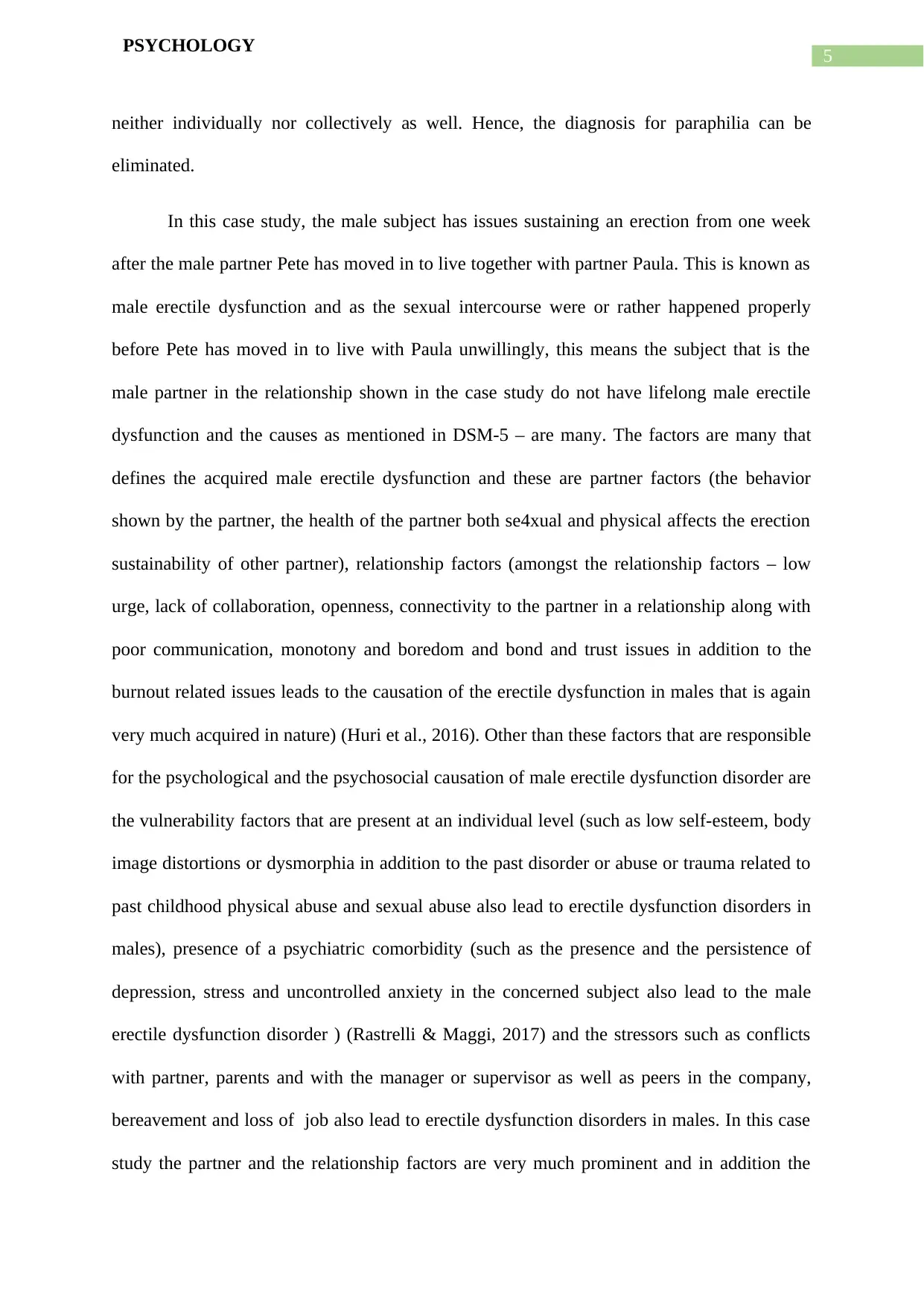
5
PSYCHOLOGY
neither individually nor collectively as well. Hence, the diagnosis for paraphilia can be
eliminated.
In this case study, the male subject has issues sustaining an erection from one week
after the male partner Pete has moved in to live together with partner Paula. This is known as
male erectile dysfunction and as the sexual intercourse were or rather happened properly
before Pete has moved in to live with Paula unwillingly, this means the subject that is the
male partner in the relationship shown in the case study do not have lifelong male erectile
dysfunction and the causes as mentioned in DSM-5 – are many. The factors are many that
defines the acquired male erectile dysfunction and these are partner factors (the behavior
shown by the partner, the health of the partner both se4xual and physical affects the erection
sustainability of other partner), relationship factors (amongst the relationship factors – low
urge, lack of collaboration, openness, connectivity to the partner in a relationship along with
poor communication, monotony and boredom and bond and trust issues in addition to the
burnout related issues leads to the causation of the erectile dysfunction in males that is again
very much acquired in nature) (Huri et al., 2016). Other than these factors that are responsible
for the psychological and the psychosocial causation of male erectile dysfunction disorder are
the vulnerability factors that are present at an individual level (such as low self-esteem, body
image distortions or dysmorphia in addition to the past disorder or abuse or trauma related to
past childhood physical abuse and sexual abuse also lead to erectile dysfunction disorders in
males), presence of a psychiatric comorbidity (such as the presence and the persistence of
depression, stress and uncontrolled anxiety in the concerned subject also lead to the male
erectile dysfunction disorder ) (Rastrelli & Maggi, 2017) and the stressors such as conflicts
with partner, parents and with the manager or supervisor as well as peers in the company,
bereavement and loss of job also lead to erectile dysfunction disorders in males. In this case
study the partner and the relationship factors are very much prominent and in addition the
PSYCHOLOGY
neither individually nor collectively as well. Hence, the diagnosis for paraphilia can be
eliminated.
In this case study, the male subject has issues sustaining an erection from one week
after the male partner Pete has moved in to live together with partner Paula. This is known as
male erectile dysfunction and as the sexual intercourse were or rather happened properly
before Pete has moved in to live with Paula unwillingly, this means the subject that is the
male partner in the relationship shown in the case study do not have lifelong male erectile
dysfunction and the causes as mentioned in DSM-5 – are many. The factors are many that
defines the acquired male erectile dysfunction and these are partner factors (the behavior
shown by the partner, the health of the partner both se4xual and physical affects the erection
sustainability of other partner), relationship factors (amongst the relationship factors – low
urge, lack of collaboration, openness, connectivity to the partner in a relationship along with
poor communication, monotony and boredom and bond and trust issues in addition to the
burnout related issues leads to the causation of the erectile dysfunction in males that is again
very much acquired in nature) (Huri et al., 2016). Other than these factors that are responsible
for the psychological and the psychosocial causation of male erectile dysfunction disorder are
the vulnerability factors that are present at an individual level (such as low self-esteem, body
image distortions or dysmorphia in addition to the past disorder or abuse or trauma related to
past childhood physical abuse and sexual abuse also lead to erectile dysfunction disorders in
males), presence of a psychiatric comorbidity (such as the presence and the persistence of
depression, stress and uncontrolled anxiety in the concerned subject also lead to the male
erectile dysfunction disorder ) (Rastrelli & Maggi, 2017) and the stressors such as conflicts
with partner, parents and with the manager or supervisor as well as peers in the company,
bereavement and loss of job also lead to erectile dysfunction disorders in males. In this case
study the partner and the relationship factors are very much prominent and in addition the
⊘ This is a preview!⊘
Do you want full access?
Subscribe today to unlock all pages.

Trusted by 1+ million students worldwide
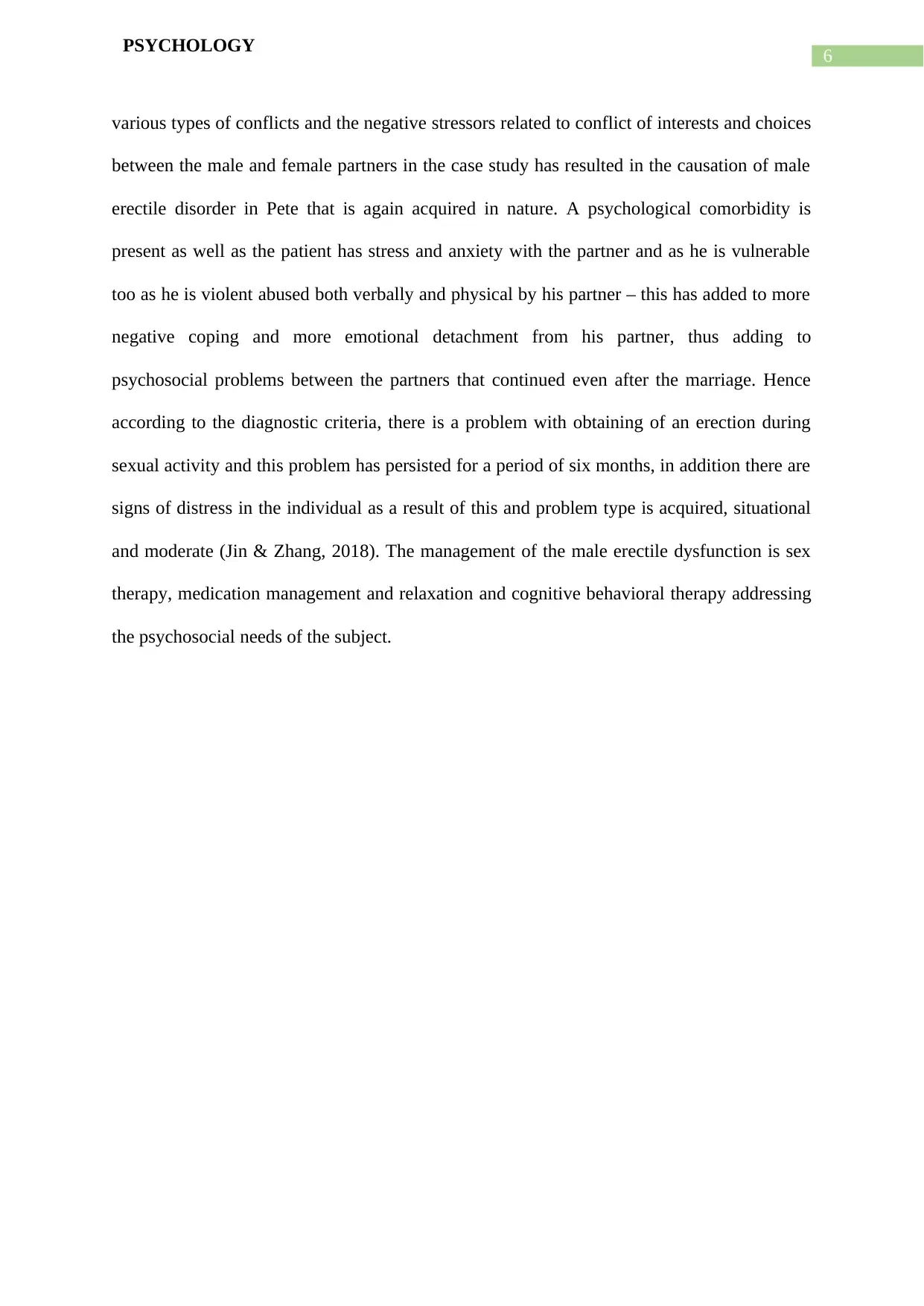
6
PSYCHOLOGY
various types of conflicts and the negative stressors related to conflict of interests and choices
between the male and female partners in the case study has resulted in the causation of male
erectile disorder in Pete that is again acquired in nature. A psychological comorbidity is
present as well as the patient has stress and anxiety with the partner and as he is vulnerable
too as he is violent abused both verbally and physical by his partner – this has added to more
negative coping and more emotional detachment from his partner, thus adding to
psychosocial problems between the partners that continued even after the marriage. Hence
according to the diagnostic criteria, there is a problem with obtaining of an erection during
sexual activity and this problem has persisted for a period of six months, in addition there are
signs of distress in the individual as a result of this and problem type is acquired, situational
and moderate (Jin & Zhang, 2018). The management of the male erectile dysfunction is sex
therapy, medication management and relaxation and cognitive behavioral therapy addressing
the psychosocial needs of the subject.
PSYCHOLOGY
various types of conflicts and the negative stressors related to conflict of interests and choices
between the male and female partners in the case study has resulted in the causation of male
erectile disorder in Pete that is again acquired in nature. A psychological comorbidity is
present as well as the patient has stress and anxiety with the partner and as he is vulnerable
too as he is violent abused both verbally and physical by his partner – this has added to more
negative coping and more emotional detachment from his partner, thus adding to
psychosocial problems between the partners that continued even after the marriage. Hence
according to the diagnostic criteria, there is a problem with obtaining of an erection during
sexual activity and this problem has persisted for a period of six months, in addition there are
signs of distress in the individual as a result of this and problem type is acquired, situational
and moderate (Jin & Zhang, 2018). The management of the male erectile dysfunction is sex
therapy, medication management and relaxation and cognitive behavioral therapy addressing
the psychosocial needs of the subject.
Paraphrase This Document
Need a fresh take? Get an instant paraphrase of this document with our AI Paraphraser
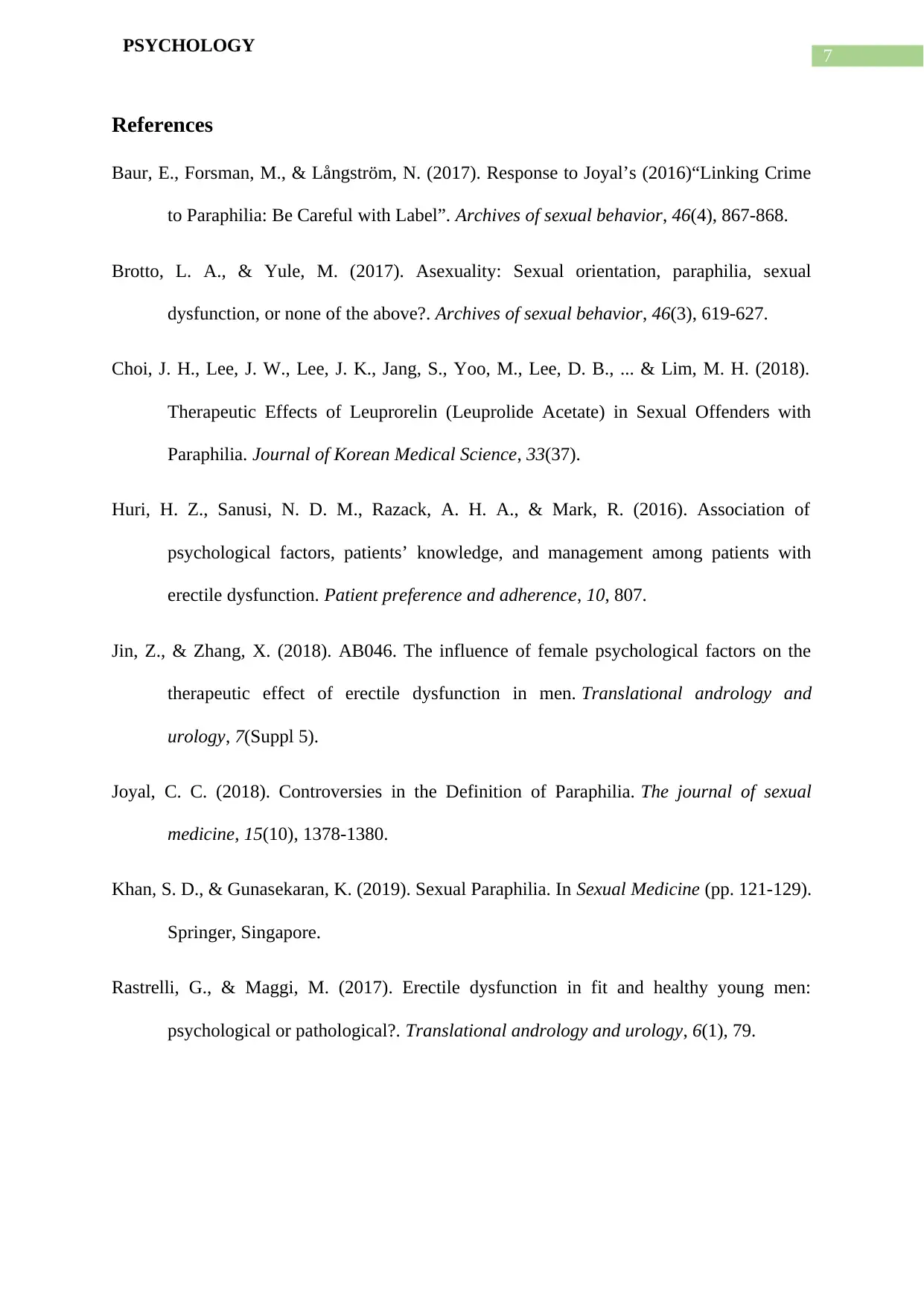
7
PSYCHOLOGY
References
Baur, E., Forsman, M., & Långström, N. (2017). Response to Joyal’s (2016)“Linking Crime
to Paraphilia: Be Careful with Label”. Archives of sexual behavior, 46(4), 867-868.
Brotto, L. A., & Yule, M. (2017). Asexuality: Sexual orientation, paraphilia, sexual
dysfunction, or none of the above?. Archives of sexual behavior, 46(3), 619-627.
Choi, J. H., Lee, J. W., Lee, J. K., Jang, S., Yoo, M., Lee, D. B., ... & Lim, M. H. (2018).
Therapeutic Effects of Leuprorelin (Leuprolide Acetate) in Sexual Offenders with
Paraphilia. Journal of Korean Medical Science, 33(37).
Huri, H. Z., Sanusi, N. D. M., Razack, A. H. A., & Mark, R. (2016). Association of
psychological factors, patients’ knowledge, and management among patients with
erectile dysfunction. Patient preference and adherence, 10, 807.
Jin, Z., & Zhang, X. (2018). AB046. The influence of female psychological factors on the
therapeutic effect of erectile dysfunction in men. Translational andrology and
urology, 7(Suppl 5).
Joyal, C. C. (2018). Controversies in the Definition of Paraphilia. The journal of sexual
medicine, 15(10), 1378-1380.
Khan, S. D., & Gunasekaran, K. (2019). Sexual Paraphilia. In Sexual Medicine (pp. 121-129).
Springer, Singapore.
Rastrelli, G., & Maggi, M. (2017). Erectile dysfunction in fit and healthy young men:
psychological or pathological?. Translational andrology and urology, 6(1), 79.
PSYCHOLOGY
References
Baur, E., Forsman, M., & Långström, N. (2017). Response to Joyal’s (2016)“Linking Crime
to Paraphilia: Be Careful with Label”. Archives of sexual behavior, 46(4), 867-868.
Brotto, L. A., & Yule, M. (2017). Asexuality: Sexual orientation, paraphilia, sexual
dysfunction, or none of the above?. Archives of sexual behavior, 46(3), 619-627.
Choi, J. H., Lee, J. W., Lee, J. K., Jang, S., Yoo, M., Lee, D. B., ... & Lim, M. H. (2018).
Therapeutic Effects of Leuprorelin (Leuprolide Acetate) in Sexual Offenders with
Paraphilia. Journal of Korean Medical Science, 33(37).
Huri, H. Z., Sanusi, N. D. M., Razack, A. H. A., & Mark, R. (2016). Association of
psychological factors, patients’ knowledge, and management among patients with
erectile dysfunction. Patient preference and adherence, 10, 807.
Jin, Z., & Zhang, X. (2018). AB046. The influence of female psychological factors on the
therapeutic effect of erectile dysfunction in men. Translational andrology and
urology, 7(Suppl 5).
Joyal, C. C. (2018). Controversies in the Definition of Paraphilia. The journal of sexual
medicine, 15(10), 1378-1380.
Khan, S. D., & Gunasekaran, K. (2019). Sexual Paraphilia. In Sexual Medicine (pp. 121-129).
Springer, Singapore.
Rastrelli, G., & Maggi, M. (2017). Erectile dysfunction in fit and healthy young men:
psychological or pathological?. Translational andrology and urology, 6(1), 79.
1 out of 8
Related Documents
Your All-in-One AI-Powered Toolkit for Academic Success.
+13062052269
info@desklib.com
Available 24*7 on WhatsApp / Email
![[object Object]](/_next/static/media/star-bottom.7253800d.svg)
Unlock your academic potential
Copyright © 2020–2025 A2Z Services. All Rights Reserved. Developed and managed by ZUCOL.





